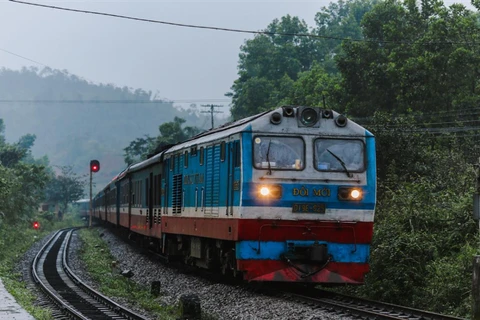 Poor infrastructure is the biggest obstacle to the development of rail freight transport. (Photo: Vietnam Plus)
Poor infrastructure is the biggest obstacle to the development of rail freight transport. (Photo: Vietnam Plus) Hanoi (VNA) - International rail freight transport has created many advantages for import and export businesses as the volume of goods transported abroad to China and Europe has increased rapidly in recent years. However, obstacles relating to infrastructure and warehouses are hindering the development of freight transport in the railway industry.
According to Vu Anh Minh, chairman of Vietnam Railways Corporation (VNR), over the past time, railway freight transport between Vietnam and China has seen an increase in transported goods. Thousands of container trucks were stuck at road border gates in Lang Son due to China’s restrictive measures to prevent the spread of the COVID-19 pandemic.
Minh said there are freight trains to China and onward to third countries in Europe, of which, goods are mainly gathered on Dong Dang Station - the border between Vietnam and China.
Trains will not be affected even when stricter regulations are being imposed thanks to a relevant process between Vietnam and China regarding the matter.
“The volume of goods transported abroad by trains in the first three months of this year surged over 30% compared to the same period last year. The trend will continue to rise in the coming time,” Minh said, adding that the corporation has seen the potential for the growth of freight transport since 2019.
A representative of the Transport & Trade Joint Stock Company (Ratraco), a unit under VNR that specialises in providing international rail freight service to Europe, said the transport of goods at Dong Dang station has increased remarkably.
The exported items were primarily ore, sulphur, chemicals, electronics and garment-textile, among others.
“The development of international railway freight transport will promote the movement of goods from the South and the Central region. This includes those that are transported through Association of Southeast Asian Nations (ASEAN) countries by domestic or international trains,” the representative said.
In addition to collecting fees for freight trains running on railways, transport and logistics enterprises also earn money from providing added services to customers. The extra services include customs clearance, warehousing, loading and unloading goods while exporters can also reduce costs.
In the immediate term, the VNR will focus on measures to promote freight transportation including calling for private investment in freight carriages, seeking capital to invest in warehouses and yards as well as reducing costs.
In the long term, the corporation will work to improve railway infrastructure and build international railway stations in the central and southern regions to reduce congestion at the borders, Minh said.
Infrastructure development
The VNR chairman said that the railway industry’s existing infrastructure and warehouse capacity is poor and doesn’t satisfy the requirements of an international transport service.
Now, only Dong Dang, Lao Cai, Yen Vien and Hai Phong stations have customs offices to carry out customs clearance. So when cargo volume increases, there is congestion of goods at these stations. Therefore, the VNR has proposed the Ministry of Transport upgrade infrastructure, including warehouses, to meet the requirements of the international railway network.
 The railway sector has shifted to freight transport to offset the loss due to a drop in passengers caused by the COVID-19 pandemic. (Photo: Vietnam Plus)
The railway sector has shifted to freight transport to offset the loss due to a drop in passengers caused by the COVID-19 pandemic. (Photo: Vietnam Plus) To improve freight capacity on the domestic and international rail, Vietnam needs to expand and upgrade Song Than, Dieu Tri, Kim Lien, Vinh, Dong Dang, Dong Anh and Kep stations to become international intermodal rail terminals.
Of which, the Kep station in Bac Giang Province would relieve cargo congestion at the border gates and two existing international intermodal stations, Yen Vien and Dong Dang.
Previously, VNR had suggested the competent authorities prioritise funding to repair and upgrade 41 stations in the 2022-2023 period. This would improve capacity and efficiency for rail freight transport, creating favourable condition for the sector to recover quickly after suffering the severe impact of the COVID-19 pandemic. The estimated cost is about 2.3 trillion VND (102 million USD), sourced from the sustainable economic recovery programme./.























